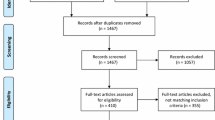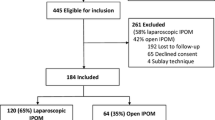Abstract
Background and aim
Several studies have claimed that mesh repair of incisional hernia lowers recurrence rates when compared to suture repair. We investigated the relative effectiveness of mesh and suture repair in a large homogeneous cohort of patients with primary incisional hernia.
Patients and methods
In a retrospective single-centre cohort study, a total of 446 consecutive patients were identified, of whom 86% could be followed up. Mean length of follow-up was 5 years. In 79 patients (22%), we implanted a mesh, usually polypropylene (Prolene).
Results
Compared to suture repair, mesh repair prolonged operating time by over 30 min and caused seroma in 12.7% of the patients (p<0.001). Only 4 of the 79 patients with mesh repair developed recurrence, compared to 55 of the 305 patients with suture repair (5 vs 18%, p=0.02 by log-rank test). In multivariate Cox regression, recurrence rates were fourfold higher after suture than after mesh repair (p=0.02). Interestingly, old age was associated with a decreased susceptibility for recurrence (p=0.01).
Conclusion
Our data confirms the long-term effectiveness of mesh repair under routine conditions. Suture repair should be restricted to small hernias in patients free of known risk factors.

Similar content being viewed by others
References
Abrahamson J (2001) Recurrent herniation: etiology and mechanisms. In: Phillips EH (ed) Abdominal wall hernias: principles and management. Springer, Berlin Heidelberg New York, pp 156–165
Amid PK, Shulman AG, Lichtenstein IL (1994) Use of Marlex mesh in the repair of recurrent incisional hernia. Br J Surg 81:1827
Amid PK, Shulman AG, Lichtenstein IL, Hakakha M (1994) Biomaterials for abdominal wall hernia surgery and principles of their applications. Langenbecks Arch Chir 379:168–171
Burger JWA, Luijendijk RW, Hop WCJ, Halm JA, Verdaasdonk EGG, Jeekel J (2004) Long-term follow-up of a randomized controlled trial of suture versus mesh repair of incisional hernia. Ann Surg 240:578–585
Carbajo MA, Martín del Olmo JC, Blanco JI, de la Cuesta C, Toledano M, Martin F, Vaquero C, Inglada L (1999) Laparoscopic treatment vs open surgery in the solution of major incisional and abdominal wall hernias with mesh. Surg Endosc 13:250–252
Carbajo MA, Martín del Olmo JC, Blanco JI, Toledano M, de la Cuesta C, Ferreras C, Vaquero C (2003) Laparoscopic approach to incisional hernia: lessons learned from 270 patients over 8 years. Surg Endosc 17:118–122
Cassar K, Munro A (2002) Surgical treatment of incisional hernia. Br J Surg 89:534–545
Chevrel JP (2001) Treatment of incisional hernias by an overlapping herniorrhaphy and onlay prosthetic implant. In: Phillips EH (ed) Abdominal wall hernias: principles and management. Springer, Berlin Heidelberg New York, pp 500–503
Holmberg L, Baum M (1995) Can results from clinical trials be generalized? Nature Med 1:734–736
Kingsnorth A, LeBlanc KA (2003) Prosthetic biomaterials for hernioplasty. In: LeBlanc KA (ed) Management of abdominal hernias, 3rd edn. Arnold, London, pp 78–104
Klinge U, Klosterhalfen B, Müller M, Schumpelick V (1999) Foreign body reaction to meshes used for the repair of abdominal wall hernias. Eur J Surg 165:665–673
Klosterhalfen B, Klinge U, Schumpelick V (1998) Functional and morphological evaluation of different polypropylene-mesh modifications for abdominal wall repair. Biomaterials 19:2235–2246
Korenkov M, Paul A, Sauerland S, Neugebauer E, Arndt M, Chevrel JP, Corcione F, Fingerhut A, Flament JB, Kux M, Matzinger A, Myrvold HE, Rath AM, Simmermacher RKJ (2001) Classification and surgical treatment of incisional hernia—results of an expert meeting. Langenbecks Arch Surg 386:65–73
Korenkov M, Sauerland S, Arndt M, Bograd L, Neugebauer EAM, Troidl H (2002) Randomized clinical trial of suture repair, polypropylene mesh or autodermal hernioplasty for incisional hernia. Br J Surg 89:50–56
Korenkov M, Sauerland S, Paul A, Neugebauer E (2002) Die deutsche Narbenhernienchirurgie im Umbruch. Ein Vergleich zweier Kliniksumfragen 1995 und 2001. Zentralbl Chir 127:700–705
Langer C, Liersch T, Kley C, Flosman M, Süss M, Siemer A, Becker H (2003) 25 Jahre Erfahrung in der Narbenhernienchirurgie. Eine vergleichende, retrospektive Studie an 432 Narbenbruchoperationen. Chirurg 74:638–645
Lehr SC, Schuricht AL (2001) A minimally invasive approach for treating postoperative seromas after incisional hernia repair. JSLS 5:267–271
Luijendijk RW, Hop WC, van den Tol MP, de Lange DC, Braaksma MM, IJzermans JNM, Boelhouwer RU, de Vries BC, Salu MKM, Wereldsma JCJ, Bruijninckx CMA, Jeekel J (2000) A comparison of suture repair with mesh repair for incisional hernia. N Engl J Med 343:392–398
Luijendijk RW, Lemmen MH, Hop WCJ, Wereldsma JCJ (1997) Incisional hernia recurrence following “vest-over-pants” or vertical Mayo repair of primary hernias of the midline. World J Surg 21:62–66
Mittermair RP, Klingler A, Wykypiel H, Gadenstätter M (2002) Vertical Mayo repair of midline incisional hernia: suggested guidelines for selection of patients. Eur J Surg 168:334–338
Paul A, Korenkov M, Peters S, Köhler L, Fischer S, Troidl H (1998) Unacceptable results of the Mayo procedure for repair of abdominal incisional hernias. Eur J Surg 164:361–367
Rosch R, Junge K, Knops M, Lynen P, Klinge U, Schumpelick V (2003) Analysis of collagen-interacting proteins in patients with incisional hernias. Langenbecks Arch Surg 387:427–432
Sauerland S, Korenkov M, Kleinen T, Arndt M, Paul A (2004) Obesity is a risk factor for recurrence after incisional hernia repair. Hernia 8:42–46
Sauerland S, Miserez M, Grass G, Stützer H, Neugebauer E (2004) LapSis: a randomised controlled multicentre trial of laparoscopic versus open ventral hernia repair using a classical versus a collagen mesh (SurgiSIS Gold) [abstract]. Langenbecks Arch Surg 389:429
Schumpelick V, Klinge U, Welty G, Klosterhalfen B (1999) Meshes in der Bauchwand. Chirurg 70:876–887
Toscano F, Agizza S, Mastantuono A, Avallone V, Bracale F, Tesauro B (1988) Terapia chirurgica del grosso laparocele: protesi inerti versus plastica diretta. Minerva Chir 43:1221–1225
White TJ, Santos MC, Thompson JS (1998) Factors affecting wound complications in repair of ventral hernias. Am Surg 64:276–280
Acknowledgements
We acknowledge the help of Jason Simpson for proofreading the manuscript.
Author information
Authors and Affiliations
Corresponding author
Rights and permissions
About this article
Cite this article
Sauerland, S., Schmedt, CG., Lein, S. et al. Primary incisional hernia repair with or without polypropylene mesh: a report on 384 patients with 5-year follow-up. Langenbecks Arch Surg 390, 408–412 (2005). https://doi.org/10.1007/s00423-005-0567-2
Received:
Accepted:
Published:
Issue Date:
DOI: https://doi.org/10.1007/s00423-005-0567-2




